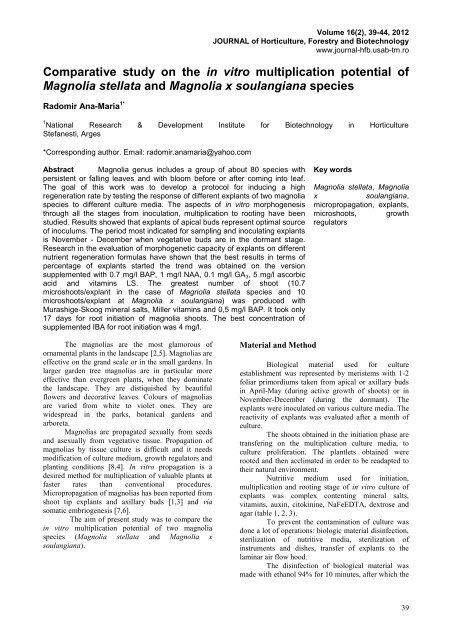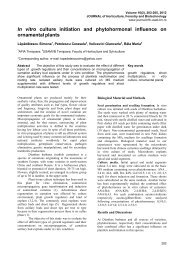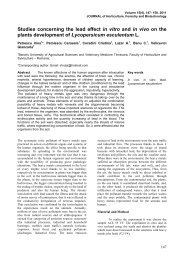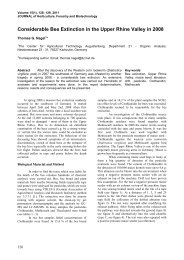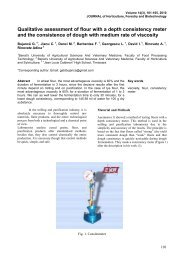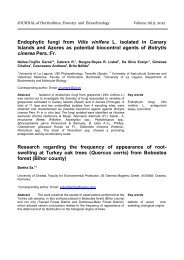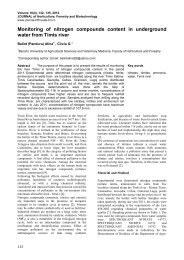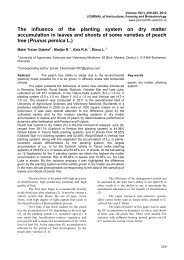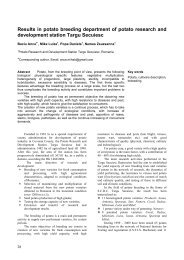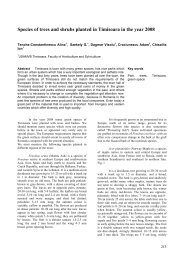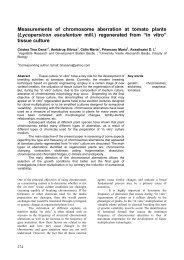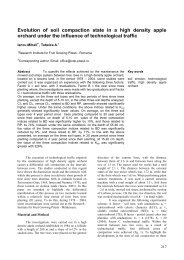Comparative study on the in vitro multiplication potential of Magnolia ...
Comparative study on the in vitro multiplication potential of Magnolia ...
Comparative study on the in vitro multiplication potential of Magnolia ...
Create successful ePaper yourself
Turn your PDF publications into a flip-book with our unique Google optimized e-Paper software.
Volume 16(2), 39-44, 2012JOURNAL <strong>of</strong> Horticulture, Forestry and Biotechnologywww.journal-hfb.usab-tm.ro<str<strong>on</strong>g>Comparative</str<strong>on</strong>g> <str<strong>on</strong>g>study</str<strong>on</strong>g> <strong>on</strong> <strong>the</strong> <strong>in</strong> <strong>vitro</strong> multiplicati<strong>on</strong> <strong>potential</strong> <strong>of</strong><strong>Magnolia</strong> stellata and <strong>Magnolia</strong> x soulangiana speciesRadomir Ana-Maria 1*1 Nati<strong>on</strong>al Research & Development Institute for Biotechnology <strong>in</strong> HorticultureStefanesti, Arges*Corresp<strong>on</strong>d<strong>in</strong>g author. Email: radomir.anamaria@yahoo.comAbstract <strong>Magnolia</strong> genus <strong>in</strong>cludes a group <strong>of</strong> about 80 species withpersistent or fall<strong>in</strong>g leaves and with bloom before or after com<strong>in</strong>g <strong>in</strong>to leaf.The goal <strong>of</strong> this work was to develop a protocol for <strong>in</strong>duc<strong>in</strong>g a highregenerati<strong>on</strong> rate by test<strong>in</strong>g <strong>the</strong> resp<strong>on</strong>se <strong>of</strong> different explants <strong>of</strong> two magnoliaspecies to different culture media. The aspects <strong>of</strong> <strong>in</strong> <strong>vitro</strong> morphogenesisthrough all <strong>the</strong> stages from <strong>in</strong>oculati<strong>on</strong>, multiplicati<strong>on</strong> to root<strong>in</strong>g have beenstudied. Results showed that explants <strong>of</strong> apical buds represent optimal source<strong>of</strong> <strong>in</strong>oculums. The period most <strong>in</strong>dicated for sampl<strong>in</strong>g and <strong>in</strong>oculat<strong>in</strong>g explantsis November - December when vegetative buds are <strong>in</strong> <strong>the</strong> dormant stage.Research <strong>in</strong> <strong>the</strong> evaluati<strong>on</strong> <strong>of</strong> morphogenetic capacity <strong>of</strong> explants <strong>on</strong> differentnutrient regenerati<strong>on</strong> formulas have shown that <strong>the</strong> best results <strong>in</strong> terms <strong>of</strong>percentage <strong>of</strong> explants started <strong>the</strong> trend was obta<strong>in</strong>ed <strong>on</strong> <strong>the</strong> versi<strong>on</strong>supplemented with 0.7 mg/l BAP, 1 mg/l NAA, 0.1 mg/l GA 3 , 5 mg/l ascorbicacid and vitam<strong>in</strong>s LS. The greatest number <strong>of</strong> shoot (10.7microshoots/explant <strong>in</strong> <strong>the</strong> case <strong>of</strong> <strong>Magnolia</strong> stellata species and 10microshoots/explant at <strong>Magnolia</strong> x soulangiana) was produced withMurashige-Skoog m<strong>in</strong>eral salts, Miller vitam<strong>in</strong>s and 0,5 mg/l BAP. It took <strong>on</strong>ly17 days for root <strong>in</strong>itiati<strong>on</strong> <strong>of</strong> magnolia shoots. The best c<strong>on</strong>centrati<strong>on</strong> <strong>of</strong>supplemented IBA for root <strong>in</strong>itiati<strong>on</strong> was 4 mg/l.Key words<strong>Magnolia</strong> stellata, <strong>Magnolia</strong>xsoulangiana,micropropagati<strong>on</strong>, explants,microshoots, growthregulatorsThe magnolias are <strong>the</strong> most glamorous <strong>of</strong>ornamental plants <strong>in</strong> <strong>the</strong> landscape [2,5]. <strong>Magnolia</strong>s areeffective <strong>on</strong> <strong>the</strong> grand scale or <strong>in</strong> <strong>the</strong> small gardens. Inlarger garden tree magnolias are <strong>in</strong> particular moreeffective than evergreen plants, when <strong>the</strong>y dom<strong>in</strong>ate<strong>the</strong> landscape. They are distiquished by beautifulflowers and decorative leaves. Colours <strong>of</strong> magnoliasare varied from white to violet <strong>on</strong>es. They arewidespread <strong>in</strong> <strong>the</strong> parks, botanical gardens andarboreta.<strong>Magnolia</strong>s are propagated sexually from seedsand asexually from vegetative tissue. Propagati<strong>on</strong> <strong>of</strong>magnolias by tissue culture is difficult and it needsmodificati<strong>on</strong> <strong>of</strong> culture medium, growth regulators andplant<strong>in</strong>g c<strong>on</strong>diti<strong>on</strong>s [8,4]. In <strong>vitro</strong> propagati<strong>on</strong> is adesired method for multiplicati<strong>on</strong> <strong>of</strong> valuable plants atfaster rates than c<strong>on</strong>venti<strong>on</strong>al procedures.Micropropagati<strong>on</strong> <strong>of</strong> magnolias has been reported fromshoot tip explants and axillary buds [1,3] and viasomatic embriogenesis [7,6].The aim <strong>of</strong> present <str<strong>on</strong>g>study</str<strong>on</strong>g> was to compare <strong>the</strong><strong>in</strong> <strong>vitro</strong> multiplicati<strong>on</strong> <strong>potential</strong> <strong>of</strong> two magnoliaspecies (<strong>Magnolia</strong> stellata and <strong>Magnolia</strong> xsoulangiana).Material and MethodBiological material used for cultureestablishment was represented by meristems with 1-2foliar primordiums taken from apical or axillary buds<strong>in</strong> April-May (dur<strong>in</strong>g active growth <strong>of</strong> shoots) or <strong>in</strong>November-December (dur<strong>in</strong>g <strong>the</strong> dormant). Theexplants were <strong>in</strong>oculated <strong>on</strong> various culture media. Thereactivity <strong>of</strong> explants was evaluated after a m<strong>on</strong>th <strong>of</strong>culture.The shoots obta<strong>in</strong>ed <strong>in</strong> <strong>the</strong> <strong>in</strong>itiati<strong>on</strong> phase aretransfer<strong>in</strong>g <strong>on</strong> <strong>the</strong> multiplicati<strong>on</strong> culture media, toculture proliferati<strong>on</strong>. The plantlets obta<strong>in</strong>ed wererooted and <strong>the</strong>n acclimated <strong>in</strong> order to be readapted to<strong>the</strong>ir natural envir<strong>on</strong>ment.Nutritive medium used for <strong>in</strong>itiati<strong>on</strong>,multiplicati<strong>on</strong> and root<strong>in</strong>g stage <strong>of</strong> <strong>in</strong> <strong>vitro</strong> culture <strong>of</strong>explants was complex c<strong>on</strong>tent<strong>in</strong>g m<strong>in</strong>eral salts,vitam<strong>in</strong>s, aux<strong>in</strong>, citok<strong>in</strong><strong>in</strong>e, NaFeEDTA, dextrose andagar (table 1, 2, 3).To prevent <strong>the</strong> c<strong>on</strong>tam<strong>in</strong>ati<strong>on</strong> <strong>of</strong> culture wasd<strong>on</strong>e a lot <strong>of</strong> operati<strong>on</strong>s: biologic material dis<strong>in</strong>fecti<strong>on</strong>,sterilizati<strong>on</strong> <strong>of</strong> nutritive media, sterilizati<strong>on</strong> <strong>of</strong><strong>in</strong>struments and dishes, transfer <strong>of</strong> explants to <strong>the</strong>lam<strong>in</strong>ar air flow hood.The dis<strong>in</strong>fecti<strong>on</strong> <strong>of</strong> biological material wasmade with ethanol 94% for 10 m<strong>in</strong>utes, after which <strong>the</strong>39
“FACULTATEA DE HORTICULTURĂ ŞI SILVICULTURĂ”material was transferred <strong>in</strong> a soluti<strong>on</strong> <strong>of</strong> calciumhypochlorite c<strong>on</strong>centrati<strong>on</strong> <strong>of</strong> 6% for ano<strong>the</strong>r 20m<strong>in</strong>utes – treatment applied <strong>on</strong> vegetat<strong>in</strong>g buds. For<strong>the</strong> buds <strong>in</strong> <strong>the</strong> foliati<strong>on</strong> stage as well as for <strong>the</strong> apicalbuds dur<strong>in</strong>g full growth, <strong>the</strong> treatment was reduced tohalf <strong>of</strong> <strong>the</strong> <strong>in</strong>itial time.The culture media were sterilized byautoclav<strong>in</strong>g at 120°C temperature for 20 m<strong>in</strong>utes.Before autoclav<strong>in</strong>g, <strong>the</strong> pH registered <strong>in</strong> a culturemedium was adjusted to 5.6-5.8.The surgical type <strong>in</strong>struments used weresterilized <strong>in</strong> <strong>the</strong> dry<strong>in</strong>g stove, at 120 o C temperature for2 hours.For <strong>the</strong> grow<strong>in</strong>g, multiplicati<strong>on</strong> and root<strong>in</strong>g <strong>of</strong>explants we ensured <strong>in</strong> <strong>the</strong> grow<strong>in</strong>g room c<strong>on</strong>trolledc<strong>on</strong>diti<strong>on</strong>s <strong>of</strong> temperature (22-24 o C), photoperiod (16hours) and light <strong>in</strong>tensity.Compositi<strong>on</strong> <strong>of</strong> nutritive media used for culture <strong>in</strong>itiati<strong>on</strong>Growth regulators used and <strong>the</strong>irVaric<strong>on</strong>centrati<strong>on</strong> <strong>in</strong> culture medium (mg/l)antsBasic mediumexperimentalascorbicBAP IAA NAA GA 3acidV.1 Macroelements MS, 1 0,2 - - -V.2 microelements MS, vitam<strong>in</strong>s JQ 0,5 - 1 0,1 5V.3 Macroelements MS, 1 0,2 - - -V.4 microelements MS, vitam<strong>in</strong>s MS 0,5 - 1 0,1 5V.51 0,2 - - -Macroelements MS,V.6 0,5 - 1 0,1 5microelements MS, vitam<strong>in</strong>s LSV.7 0,7 - 1 0,1 5Legend: MS = Murashige - Skoog (1962); LS = L<strong>in</strong>smaier – Skoog (1965); JQ = Jaquoit (1956)VariantsexperimentalCompositi<strong>on</strong> <strong>of</strong> nutritive media used for micropropagati<strong>on</strong>Basic mediumGrowth regulators used and <strong>the</strong>irc<strong>on</strong>centrati<strong>on</strong> <strong>in</strong> culture medium (mg/l)BAP 2iP TDZ K<strong>in</strong>0,25 - - -V.1V.2 0,5 - - -V.3V.4V.5Macroelements MS,microelements MS,vitam<strong>in</strong>s M---0,250,5---0,25---V.6 - - 0,5 -V.7 - - - 0,25V.8 - - - 0,5Legend: MS = Murashige - Skoog (1962); M = Miller şi colab. (1982)ACompositi<strong>on</strong> <strong>of</strong> nutritive media used for <strong>in</strong> <strong>vitro</strong> root<strong>in</strong>g <strong>of</strong> shootsGrowth regulators used and <strong>the</strong>irVariantsBasic medium c<strong>on</strong>centrati<strong>on</strong> <strong>in</strong> culture medium (mg/l)experimentalIBA GA 3V.1- 0,1V.2 2 0,1V.3 Macroelements MS½ n,4 0,1V.4 microelements MS½ n,6 0,1V.5 vitam<strong>in</strong>s LS n8 0,1V.6 10 0,1V.7 12 0,1V.8 14 0,1Legend: MS = Murashige - Skoog (1962); LS = L<strong>in</strong>smaier – Skoog (1965)Table 1Table 2Table 3The achieved results was registered asmultiplicati<strong>on</strong> rate be<strong>in</strong>g express <strong>in</strong>microshoots/explants and was statistic <strong>in</strong>terpretati<strong>on</strong> byDuncan Test. Grow<strong>in</strong>g <strong>of</strong> explants and root<strong>in</strong>g <strong>of</strong>microcutt<strong>in</strong>gs was express <strong>in</strong> percents.40
Results Obta<strong>in</strong>edThe <strong>in</strong>itiati<strong>on</strong> phaseThe reactivity <strong>of</strong> different types <strong>of</strong> explants <strong>on</strong>various culture media was tested <strong>in</strong> order to establishexperimental protocol for <strong>in</strong> <strong>vitro</strong> multiplicati<strong>on</strong> <strong>of</strong>magnolia species.In <strong>the</strong> <strong>in</strong>itiati<strong>on</strong> stage <strong>of</strong> <strong>in</strong> <strong>vitro</strong> culture, <strong>the</strong>grow<strong>in</strong>g <strong>of</strong> explants was <strong>in</strong>fluenced by <strong>the</strong> type <strong>of</strong>explants and compositi<strong>on</strong> <strong>of</strong> nutritive media.Results obta<strong>in</strong>ed have shown that explants <strong>of</strong>apical buds represent optimal source <strong>of</strong> <strong>in</strong>oculums.The period most <strong>in</strong>dicated for sampl<strong>in</strong>g and<strong>in</strong>oculat<strong>in</strong>g explants is November-December whenvegetative buds are <strong>in</strong> <strong>the</strong> dormant stage. Research <strong>in</strong><strong>the</strong> evaluati<strong>on</strong> <strong>of</strong> morphogenetic capacity <strong>of</strong> explantsshowed that nutrient media compositi<strong>on</strong> <strong>in</strong>fluencedreactivity <strong>of</strong> explants taken dur<strong>in</strong>g active growth <strong>of</strong>buds similar with explants taken from dormant stage,differences c<strong>on</strong>sist<strong>in</strong>g <strong>of</strong> percentages <strong>of</strong> explants turnedevolv<strong>in</strong>g, which were lower.It was found that <strong>the</strong> best results <strong>in</strong> terms <strong>of</strong>percentage <strong>of</strong> explants started <strong>the</strong> trend was obta<strong>in</strong>ed<strong>on</strong> <strong>the</strong> versi<strong>on</strong> supplemented with 0.7 mg/l BAP, 1mg/l NAA, 0.1 mg/l GA 3 , 5 mg/l ascorbic acid andvitam<strong>in</strong>s LS (V.7), followed <strong>the</strong> versi<strong>on</strong>s V6, V3, V5,V4, V1 and V2.In general, nutrient media compositi<strong>on</strong><strong>in</strong>fluenced <strong>the</strong> reactivity <strong>of</strong> explants taken <strong>of</strong> axillarybuds similar with explants taken from apical buds,differences c<strong>on</strong>sist<strong>in</strong>g <strong>of</strong> percentage <strong>of</strong> explants startedevolv<strong>in</strong>g, that were smaller (fig. 1).apical budaxillary budFig. 1. The <strong>in</strong> <strong>vitro</strong> reactivity <strong>of</strong> magnolia species c<strong>on</strong>sider<strong>in</strong>g <strong>the</strong> explant type, genotype and culture mediumcompositi<strong>on</strong>Fig. 2. Morphogenetic resp<strong>on</strong>se <strong>of</strong> explants, 4 weeks after <strong>in</strong>itiati<strong>on</strong> <strong>of</strong> <strong>in</strong> <strong>vitro</strong> cultureThe multiplicati<strong>on</strong> phaseIn multiplicati<strong>on</strong> phase, <strong>the</strong> analysis <strong>of</strong> <strong>the</strong>effect <strong>of</strong> type and c<strong>on</strong>centrati<strong>on</strong> <strong>of</strong> citok<strong>in</strong><strong>in</strong>e could beseen <strong>the</strong> clearly <strong>in</strong>fluence <strong>of</strong> citok<strong>in</strong><strong>in</strong>e type <strong>on</strong> <strong>the</strong>regenerati<strong>on</strong> rate.In <strong>the</strong> case <strong>of</strong> <strong>Magnolia</strong> stellata species,referr<strong>in</strong>g to <strong>the</strong> effect <strong>of</strong> citok<strong>in</strong><strong>in</strong>e depend<strong>in</strong>g <strong>on</strong> its41
“FACULTATEA DE HORTICULTURĂ ŞI SILVICULTURĂ”c<strong>on</strong>centrati<strong>on</strong> was found that <strong>the</strong> best results <strong>in</strong> terms<strong>of</strong> multiplicati<strong>on</strong> rate (10.7 microshoots/explant,respectively 8.9 microshoots/explant) was recorded <strong>on</strong><strong>the</strong> versi<strong>on</strong>s that c<strong>on</strong>ta<strong>in</strong> a higher BAP (0.5 mg/l - V.2)and K (0.5 mg/l - V.8). On <strong>the</strong> nutritive media <strong>in</strong> witchBAP and K were found <strong>in</strong> lower c<strong>on</strong>centrati<strong>on</strong>s (0.25mg/l - V.1 and V.7), <strong>the</strong> number <strong>of</strong> shoots/explantshowed values lower than <strong>the</strong> alternatives discussedabove (8.2 microshoots/explant and 4.3microshoots/explant). On versi<strong>on</strong>s supplemented with2iP (V.3 and V.4) and TDZ (V.5 and V.6) regenerati<strong>on</strong>rate was 0, <strong>in</strong> both c<strong>on</strong>centrati<strong>on</strong>s used.In general, <strong>the</strong> type and c<strong>on</strong>centrati<strong>on</strong> <strong>of</strong>citok<strong>in</strong><strong>in</strong>e had a similar <strong>in</strong>fluence <strong>on</strong> <strong>the</strong> multiplicati<strong>on</strong>rate <strong>of</strong> <strong>Magnolia</strong> x soulangiana species differencesc<strong>on</strong>sist<strong>in</strong>g <strong>in</strong> <strong>the</strong> multiplicati<strong>on</strong> rate values were lower(fig. 3).<strong>Magnolia</strong> stellata<strong>Magnolia</strong> x soulangianaFig. 3. Influence <strong>of</strong> type and c<strong>on</strong>centrati<strong>on</strong> <strong>of</strong> citok<strong>in</strong><strong>in</strong>e for <strong>the</strong> multiplicati<strong>on</strong> rateFig. 4. Multiple shoot proliferati<strong>on</strong> <strong>on</strong> MS medium supplemented with 0.5 mg/l BAPThe root<strong>in</strong>g phaseObservati<strong>on</strong>s made after 32 days <strong>of</strong> culturerevealed that magnolia has a good behaviour <strong>in</strong> <strong>vitro</strong>root<strong>in</strong>g process, <strong>the</strong> differences registered at <strong>the</strong>root<strong>in</strong>g percentages were <strong>in</strong>fluenced by <strong>the</strong>compositi<strong>on</strong> <strong>of</strong> culture media, especially by <strong>the</strong>c<strong>on</strong>centrati<strong>on</strong> <strong>of</strong> <strong>in</strong>dolilbutiric acid.Observati<strong>on</strong>s <strong>in</strong> <strong>the</strong> first 14 days <strong>of</strong> <strong>in</strong>cubati<strong>on</strong>revealed no <strong>in</strong>itiati<strong>on</strong> process rootedness. Appearance<strong>of</strong> <strong>the</strong> first primary root was recorded after 17 days <strong>of</strong>culture, regardless <strong>of</strong> <strong>the</strong> culture medium used.In <strong>the</strong> case <strong>of</strong> <strong>Magnolia</strong> stellata species, <strong>on</strong><strong>the</strong> c<strong>on</strong>trol variant (without IBA) has identified <strong>the</strong>lowest number <strong>of</strong> microshoots rooted respectively <strong>in</strong><strong>the</strong> proporti<strong>on</strong> <strong>of</strong> 10-15% at each <strong>in</strong>terval <strong>of</strong><strong>in</strong>cubati<strong>on</strong>, by <strong>the</strong> end <strong>of</strong> 32 days <strong>of</strong> experiment.The highest values <strong>of</strong> <strong>the</strong> root<strong>in</strong>g rate (90%)occurred after 24 days <strong>of</strong> culture at a c<strong>on</strong>centrati<strong>on</strong> <strong>of</strong> 4mg/l IBA (fig. 5).42
Fig. 5. The <strong>in</strong>fluence <strong>of</strong> <strong>in</strong>dolilbutiric acid over root<strong>in</strong>g <strong>of</strong> <strong>Magnolia</strong> stellata microshootsIn general, IBA c<strong>on</strong>centrati<strong>on</strong> had a similar <strong>in</strong>fluence<strong>on</strong> <strong>the</strong> percentage <strong>of</strong> rooted microshoots <strong>in</strong> <strong>the</strong> case <strong>of</strong><strong>Magnolia</strong> x soulangiana species, but <strong>the</strong>ir values arelower (fig. 6).Fig. 6. The <strong>in</strong>fluence <strong>of</strong> <strong>in</strong>dolilbutiric acid over root<strong>in</strong>g <strong>of</strong> <strong>Magnolia</strong> x soulangiana microshootsFig. 7. In <strong>vitro</strong> root<strong>in</strong>g <strong>of</strong> shoots <strong>on</strong> ½ MS medium supplemented with 4 mg/l IBA43
“FACULTATEA DE HORTICULTURĂ ŞI SILVICULTURĂ”Rooted plantlets had been acclimatized <strong>in</strong> <strong>the</strong> greenhouse and transferr<strong>in</strong>g to <strong>the</strong> soil substrate (fig. 8).Fig. 8. <strong>Magnolia</strong> plants after transfer from greenhouse c<strong>on</strong>diti<strong>on</strong>s to soilC<strong>on</strong>clusi<strong>on</strong>s1. The results presented <strong>in</strong> this paper <strong>in</strong>dicatethat <strong>the</strong> percentage <strong>of</strong> regenerat<strong>in</strong>g, shoot number perexplant, percentage <strong>of</strong> root<strong>in</strong>g were affected bygenotype and <strong>the</strong> <strong>in</strong>teracti<strong>on</strong> <strong>of</strong> genotype with <strong>the</strong>culture media. Between <strong>Magnolia</strong> stellata and<strong>Magnolia</strong> x soulangiana species tested, <strong>the</strong> best resultsas well as percent <strong>of</strong> regenerati<strong>on</strong>, number <strong>of</strong> shootsper explant and root<strong>in</strong>g rate were recorded for<strong>Magnolia</strong> stellata species.2. Explants <strong>of</strong> apical buds represent optimalsource <strong>of</strong> <strong>in</strong>oculums. The period most <strong>in</strong>dicated forsampl<strong>in</strong>g and <strong>in</strong>oculat<strong>in</strong>g explants is November-December when vegetative buds are <strong>in</strong> <strong>the</strong> dormantstage.3. Research <strong>in</strong> <strong>the</strong> evaluati<strong>on</strong> <strong>of</strong>morphogenetic capacity <strong>of</strong> explants <strong>on</strong> differentnutrient regenerati<strong>on</strong> formulas and results obta<strong>in</strong>edhave shown that <strong>the</strong> best results <strong>in</strong> terms <strong>of</strong> percentage<strong>of</strong> explants started <strong>the</strong> trend was obta<strong>in</strong>ed <strong>on</strong> <strong>the</strong>versi<strong>on</strong> supplemented with 0.7 mg/l BAP, 1 mg/lNAA, 0.1 mg/l GA 3 , 5 mg/l ascorbic acid and vitam<strong>in</strong>sLS.4. Our results dem<strong>on</strong>strate <strong>the</strong> clearly<strong>in</strong>fluence <strong>of</strong> citok<strong>in</strong><strong>in</strong>e type <strong>on</strong> <strong>the</strong> regenerati<strong>on</strong> rate.The best shoot multiplicati<strong>on</strong> rate (10.7microshoots/explant <strong>in</strong> <strong>the</strong> case <strong>of</strong> <strong>Magnolia</strong> stellataspecies and 10 microshoots/explant at <strong>Magnolia</strong> xsoulangiana) was established with Murashige-Skoogm<strong>in</strong>eral salts, Miller vitam<strong>in</strong>s and 0,5 mg/l BAP.5. It took <strong>on</strong>ly 17 days for root <strong>in</strong>itiati<strong>on</strong> <strong>of</strong>magnolia shoots. The best c<strong>on</strong>centrati<strong>on</strong> <strong>of</strong>supplemented IBA for root <strong>in</strong>itiati<strong>on</strong> was 4 mg/l.6. The results obta<strong>in</strong>ed <strong>in</strong> our <strong>in</strong>vestigati<strong>on</strong>sproved that <strong>in</strong> <strong>vitro</strong> culture could be used as anefficient alternative method for multiplicati<strong>on</strong> <strong>of</strong><strong>Magnolia</strong> stellata and <strong>Magnolia</strong> x soulangiana species.Bibliography1. Biederman I. E. G. - 1987 - Factors affect<strong>in</strong>gestablishment and development <strong>of</strong> <strong>Magnolia</strong> hybrids <strong>in</strong><strong>vitro</strong>, Acta Horticulturae, 212, s. 625-629.2. Callaway D.J. – 1994 - The world <strong>of</strong> <strong>Magnolia</strong>s,Timber Press, Portland, 260 pp.3. Kamenicka Aurelia, Lanakova Maria – 2000 -Effect <strong>of</strong> medium compositi<strong>on</strong> and type <strong>of</strong> vesselclosure <strong>on</strong> axillary shoot producti<strong>on</strong> <strong>of</strong> magnolia <strong>in</strong><strong>vitro</strong>, Acta Physiologiae Plantarum, vol: 22, number: 2,pages: 129-134.4. Kamenicka Aurelia, Takats J. – 1997 - <strong>Magnolia</strong>, 1:1-6.5. Liu Y.H. – 2004 - <strong>Magnolia</strong> <strong>of</strong> Ch<strong>in</strong>a. Beij<strong>in</strong>gScience&Technology Press, 391 pp.6. Merkle S.A. - 1995 - Somatic embryogenesis <strong>in</strong><strong>Magnolia</strong>ceae (Liliodendr<strong>on</strong> and <strong>Magnolia</strong>s). In: BajajY.P.S. (ed.) Somatic embryogenesis and Syn<strong>the</strong>ticSeed I. Spr<strong>in</strong>ger-Verlag, Berl<strong>in</strong>, Heidelberg: 388-403.7. Merkle S.A., Wats<strong>on</strong>-Pauley B.A. – 1994 - Ex <strong>vitro</strong>c<strong>on</strong>versi<strong>on</strong> <strong>of</strong> pyramid magnolia somatic embryos,HortScience, v. 29(10) p. 1186-1188.8. Tobe J.D. – 1990 - Journal <strong>of</strong> <strong>Magnolia</strong> Soc., 26 : 4844


